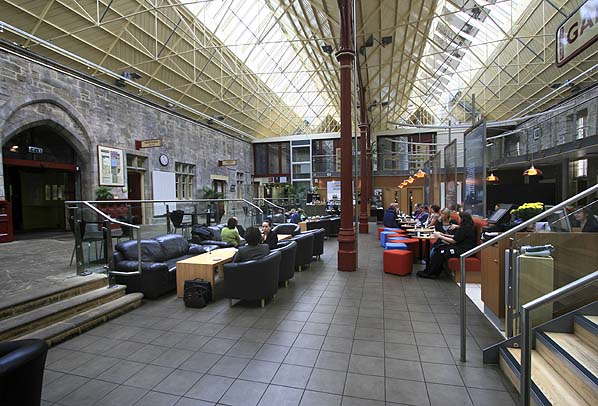Disused Stations: Richmond Station (original) (raw)
Notes: The main station building was the work of the architect GT Andrews of York and was specifically designed to blend in with the buildings and character of this historic market town. The two ridge train shed covered a platform line and two sidings. These sidings often used to house NE horseboxes hired out to local trainers for their racehorses. Often the boxes displayed the name of the hirer and the home station in gold lettering on the door panel. The original platform was both low and short, extending only a short distance outside the train shed. At the main entrance there was a carriage porch where a horse and carriage or motor vehicle could stop in order for the occupants to alight under cover, protected from the weather.
 The train shed was open at the south end and lit by gas; electricity not being provided until after WW2. Within the train shed the following rooms were provided: booking office, general waiting room (later incorporated into an enlarged parcels office), ladies waiting room, refreshment room (later the waiting room), parcels office (later enlarged), stationmaster’soffice, porter’s room and toilets. At a later date a wooden ticket collectors booth was provided next to the main entrance and in the 20th century there was a small wooden bookstall operated by WH Smiths, which closed in 1940.
The train shed was open at the south end and lit by gas; electricity not being provided until after WW2. Within the train shed the following rooms were provided: booking office, general waiting room (later incorporated into an enlarged parcels office), ladies waiting room, refreshment room (later the waiting room), parcels office (later enlarged), stationmaster’soffice, porter’s room and toilets. At a later date a wooden ticket collectors booth was provided next to the main entrance and in the 20th century there was a small wooden bookstall operated by WH Smiths, which closed in 1940.
Few substantial alterations were made to the station building over the years other than lengthening the platform in 1860 when the front edge was raised resulting in a downward slope towards the floor level of the offices, which survived until the recent renovations. The platform was further lengthened in 1892 and again 1915 to cope with the increased military traffic from the newly established Catterick Camp and in its final form was 268 yards long.
The rearrangements of the offices and waiting rooms was carried out during the First World War, and at about the same time the large window at the buffer stop end of the platform was opened up to create a large door for handling parcels traffic.
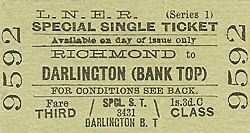 The station bookstall was removed in 1940 and during the Second World War the stationmaster's office was requisitioned by the army as the Railway Transport Officer (RTO) Office. The RTO also had a temporary wooden office under the carriage porch. Electric lighting was finally installed in the late 1940s, but apart from that little was spent on the building in British Railways days. In the 1950s the rotten wooden screen above the platform line was patched with zinc sheeting, and by the time of closure there were gaps in the wooden screen, smoke louvers and roof lights.
The station bookstall was removed in 1940 and during the Second World War the stationmaster's office was requisitioned by the army as the Railway Transport Officer (RTO) Office. The RTO also had a temporary wooden office under the carriage porch. Electric lighting was finally installed in the late 1940s, but apart from that little was spent on the building in British Railways days. In the 1950s the rotten wooden screen above the platform line was patched with zinc sheeting, and by the time of closure there were gaps in the wooden screen, smoke louvers and roof lights.
Outside the station train shed was an extensive layout of sidings used for loading timber led down by three huge horses. A firm from Sedgefield loaded many tons of timber here. Generous facilities were provided for Goods Traffic, together with facilities for railway operations and staff accommodation. These included:
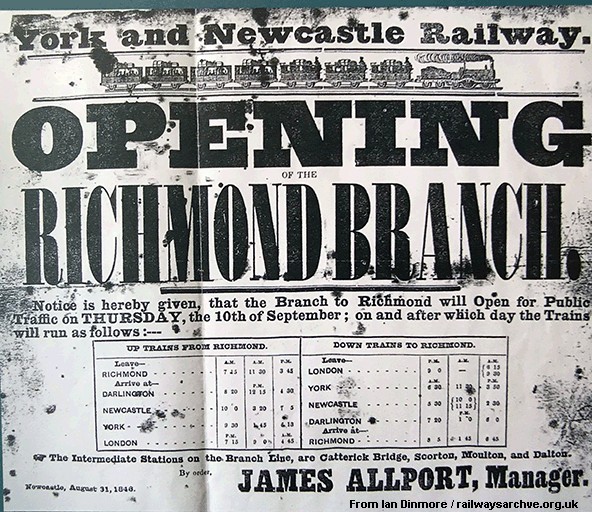
A large goods shed (now the site of the swimming pool), two road engine shed (now a fitness centre). One of the shed’s roads was a through road, giving access to the coal depot. There was a 45 ft turntable, situated on an outside line near the engine shed. In April 1877 a request was made for a replacement for the original, reportedly worn out, turntable. The decision was taken to work the branch with tank engines rather than replace the turntable, this decision was rescinded a few years later and a new Lanson turntable was installed.
Other buildings included gasworks to provide gas for the lighting; this was sometimes referred to as the pump house and is currently derelict. There was a signal box of the early type of the NER Southern Division architecture, this was sited on the south side of the line close by the railway cottages and was demolished in 1968. There was also a water pumping station, 50 coal drops (now the site of the car park) and a 3-ton crane.
Staff accommodation included a stationmaster's house, goods agent’s house, two goods staff cottages, one being the depot managers house at the entrance to the coal yard and 6 staff cottages.
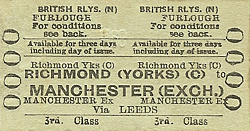 As there was no road access to the station the railway constructed a road bridge over the River Swale and built a road up in to the town to provide access to the station. This bridge with 4 gothic arches of 52 feet span and 10 feet rise was designed by Robert Stephenson, Engineer–in-Chief of the York & Newcastle Railway (Although some sources credit GT Andrews). This bridge was almost unique in that it was a railway owned bridge carrying a road over a river. For 70 years the road over the bridge served only the station but with the building of the Catterick Camp a link was made with the Richmond to Catterick road. The bridge, known simply as Station Bridge,It was taken over by the Town Council about 1920 but still retains its North Eastern Railway bridge plates ' No 8'. This bridge is now known as Mercury Bridge in honour of the close association between the town and the Royal Corps of Signals.
As there was no road access to the station the railway constructed a road bridge over the River Swale and built a road up in to the town to provide access to the station. This bridge with 4 gothic arches of 52 feet span and 10 feet rise was designed by Robert Stephenson, Engineer–in-Chief of the York & Newcastle Railway (Although some sources credit GT Andrews). This bridge was almost unique in that it was a railway owned bridge carrying a road over a river. For 70 years the road over the bridge served only the station but with the building of the Catterick Camp a link was made with the Richmond to Catterick road. The bridge, known simply as Station Bridge,It was taken over by the Town Council about 1920 but still retains its North Eastern Railway bridge plates ' No 8'. This bridge is now known as Mercury Bridge in honour of the close association between the town and the Royal Corps of Signals.
Goods traffic was withdrawn on 2nd October 1967 and this enabled the railway to lift all the sidings, including the two in the train shed, and remove all the signals. All points were secured out of use in the normal position, pending removal. Before proceeding from Richmond station the guard had to receive assurance from the Catterick Bridge signalman that the gates at Broken Brae and Parkgate Lane level crossings were secured across the roads. In August 1968, Richmond signal box and the 1942 water column on the station platform were demolished and redundant track removed. The station was finally closed on 3 March 1969 but before the line was closed the station was included in the list of buildings of Special Architectural or Historic Interest, it is now Grade II* listed. After closure the remaining track was lifted and the building lay derelict until the whole site was acquired by the District Council.
After closure the goods shed was demolished but the rest of the railway infrastructure survived
including the bridge which continues to form part of the main road between Richmond and Catterick Garrison, the A6136.
Eventually the passenger terminus became a popular farm and garden centre, though it closed in 2001. In 2003 a community-based project to regenerate the station was given the go ahead. The aims of the project, which was spearheaded by the Richmondshire Building Preservation Trust, were "to provide activities and recreational spaces that will meet established local demands at affordable prices.
To include a limited number of commercial operations sufficient to generate an income to maintain the project and subsidise community activities on site. To include at least one use that will attract substantial numbers of visitors to provide the building tenants, and (as a consequence) the building management, with income."
The building re-opened, named simply The Station on 9 November 2007, with two cinema screens, a restaurant and café-bar, an art gallery, a heritage centre, a number of rooms for public use, and a
range of artisan food-producers. There is also a regular exhibition depicting the history of the line
with photographs by railway photographer Maurice Burns.
Additional source Wikipedia, some text reproduced under Creative Commons Licence.
See also Richmond Station web site. The station is open every day except Christmas Day, from 0900 to 2300. The food units in The Station, which are run by independent traders, have their own hours.
BRIEF HISTORY OF THE RICHMOND BRANCH & THE CATTERICIK MILITARY RAILWAY
In 1841 the Great North of England Railway (GNER) opened its line between York and Darlington. In order to generate revenue from the highly profitable lead mines in Swaledale the company proposed a branch from their line to Richmond which was authorised by the Great North of England Railway Act of 21st July, 1845. Considering the main reason for building the line was to provide railhead for mining traffic it's surprising that the branch terminated some distance short of the main mining area to the west of Richmond. Prior to the line being built, lead ore had to be transported to the Stockton & Darlington terminus at Croft (adjacent to the later Croft Spa Station) and with the opening of the York line in 1841 a new railhead was established at Cowton.
Before the line was built, the GNER was leased by the Newcastle and Darlington Junction Railway which had opened a line between Darlington and Gateshead in 1842. At this time the NDJR was renamed York & Newcastle Railway on 27th July 1846.
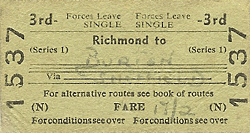 The 9 mile 62 chain double track branch opened on 10th September 1846 from a junction station on the York line at Dalton, 6 miles south of Darlington between Croft and Cowton with intermediate stations at Moulton, Scorton and Catterick Bridge. Initially there were three trains each day between Richmond and Darlington with a journey time of 45 minutes. By the end of the year a fourth daily train had been added with three on Sunday. The York & Newcastle Railway only survived for a further 7 years after the opening of the line, becoming part of the North Eastern Railway in 1854.
The 9 mile 62 chain double track branch opened on 10th September 1846 from a junction station on the York line at Dalton, 6 miles south of Darlington between Croft and Cowton with intermediate stations at Moulton, Scorton and Catterick Bridge. Initially there were three trains each day between Richmond and Darlington with a journey time of 45 minutes. By the end of the year a fourth daily train had been added with three on Sunday. The York & Newcastle Railway only survived for a further 7 years after the opening of the line, becoming part of the North Eastern Railway in 1854.
There were a number of later proposals to extend the branch west from Richmond to reach the Swaledale mines, these including the Reeth & Richmond Railway which was authorised in 1869 but no extension was ever built.
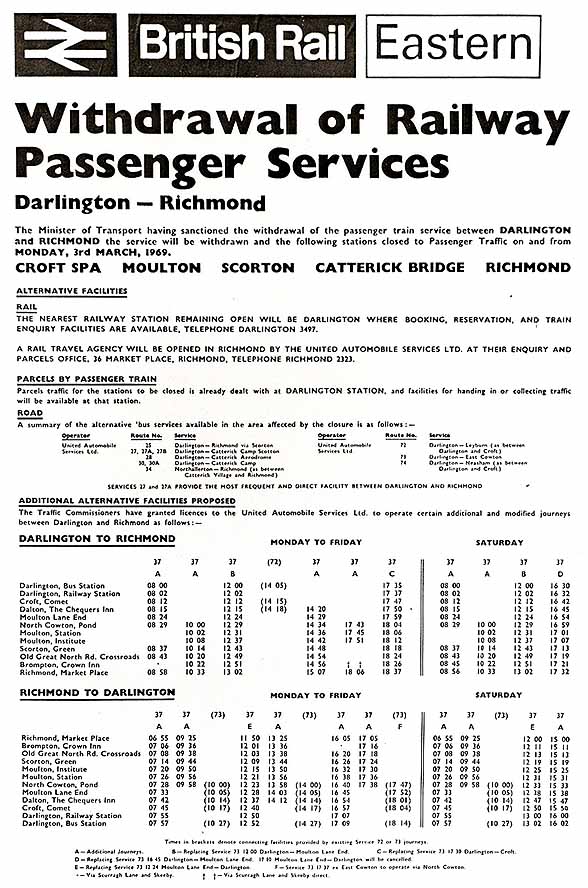
In the early days, many branch trains terminated at Dalton Junction which served no community and had no road access being no more than an interchange station for the Darlington - York line. Dalton (renamed Eryholme in 1901) was an early closure losing its regular service in 1911 with all trains then terminating at Darlington and calling additionally at Croft Spa on the main line. For a time Croft Spa became the interchange station for passengers travelling south.
 The service on the branch gradually improved with five daily trains in 1870 and seven in 1906. A number of excursions also ran into Richmond, notably for the annual Whit Monday 'Athletic Sports and Bicycle Meet' with specials from Middlesbrough, Saltburn and Bishop Auckland and additional trains running from Darlington.
The service on the branch gradually improved with five daily trains in 1870 and seven in 1906. A number of excursions also ran into Richmond, notably for the annual Whit Monday 'Athletic Sports and Bicycle Meet' with specials from Middlesbrough, Saltburn and Bishop Auckland and additional trains running from Darlington.
The level of service remained much the same until WW1 and the opening of the 4 mile steeply graded Catterick Military Railway from a trailing connection at Catterick Bridge station to Catterick Camp two miles south of Richmond. The idea for a military camp in the area had first been proposed by Lord Baden Powell in 1908 but construction didn't start until 1914 a few weeks after the outbreak of WW1. During building of the camp, a 2' gauge contractor’s line was built from Catterick Bridge. This was completed by May 1915 and converted to standard gauge by the end of the year. Stations were provided at Brompton Road, close to Catterick Bridge Station, Camp Centre, California and Scotton. Although built to light railway standards all locomotive classes were permitted on the line which was also capable of carrying the large cross-channel railway guns used in WW2.
 The first soldiers arrived at the camp in October 1916 and troop traffic was immediately very heavy with seven passenger trains operating between Catterick Bridge and the camp, the last two running through to California. Five trains ran in the opposite direction with an extra train at lunch time on Saturday although no trains ran from California. On Sundays there were two trains between Catterick Bridge and Camp Centre. Some trains between Camp Centre and Darlington were combined with trains for Richmond dividing at Catterick Bridge where the camp's own tank engine was waiting to haul the detached coaches on to Camp Centre. The camp's tank engine was kept in a 2-road corrugated iron shed opened in 1915. It stood south west of Walkerville Crossing and closed in c.1925.
The first soldiers arrived at the camp in October 1916 and troop traffic was immediately very heavy with seven passenger trains operating between Catterick Bridge and the camp, the last two running through to California. Five trains ran in the opposite direction with an extra train at lunch time on Saturday although no trains ran from California. On Sundays there were two trains between Catterick Bridge and Camp Centre. Some trains between Camp Centre and Darlington were combined with trains for Richmond dividing at Catterick Bridge where the camp's own tank engine was waiting to haul the detached coaches on to Camp Centre. The camp's tank engine was kept in a 2-road corrugated iron shed opened in 1915. It stood south west of Walkerville Crossing and closed in c.1925.
Each year until the end of the war 750,000 soldiers passed through the camp almost all of them being carried by train. Goods traffic carried by the branch was also high, increasing as the war progressed with a daily goods train with 60 - 70 wagons running every day between 1917 - 1918.
After the war, the War Department decided to make the camp permanent and when the Richmond branch became part of the London & North Eastern Railway under the 1923 Grouping the running of the Catterick Military Railway was handed over to the LNER although the line was cut back to Power House sidings and California & Scotton stations were not used after 1919 and the track was lifted.

In 1923 all passenger trains on the Richmond branch were worked by a locomotive from Richmond shed with the exception of the 7.55 am from Darlington and the 9.30 am return which was worked from Darlington shed. In later years more locomotives from Darlington shed were used and after Richmond shed closed on 30th December 1933 all locomotives came from Darlington. From 1st May 1933 the branch was operated by Sentinel steam railcars but by 1937 these had largely been withdrawn and only operated the Sunday service.
During the inter-war years there were freight and troop trains running into the camp from the main line with local and leave traffic being handled by a daily push-and-pull shuttle service running between Camp centre and Brompton Road Platform from where soldiers could transfer to the public service at Catterick Bridge, this ran until 1947. During WW2 some 'leave' trains ran through to Darlington reaching a peak of 3 - 4 on weekdays and 5 on Sundays. During this period the line was generally worked by large tank engines due to the increase in military traffic although on troop specials during and after the war virtually any class of large locomotive could appear. Between 1943 - 1946 some trains stopped at Eryholme to serve Scorton airfield near Catterick Bridge.
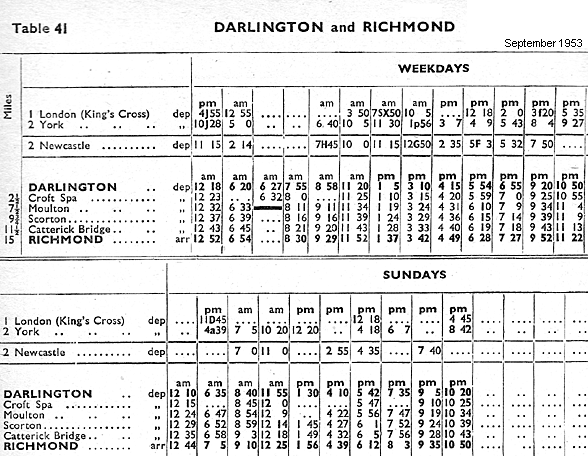
After the war military traffic was in decline with only weekend 'leave' trains and a daily goods service and by the late 1950s there was just a Friday afternoon departure for Newcastle and a Saturday lunchtime departure for London with three early Monday morning trains returning to the camp from Darlington.
 By the late 1950s, the Richmond line was operated entirely by DMUs with 12 daily trains and an extra one on Mondays and Saturdays and three on Sundays but BR claimed that the branch was running at a loss. On 10th October, 1963, the North Eastern Region of British Railways gave notice of their intention to withdraw all passenger services, (except certain military trains), between Darlington and Richmond. Following objections, the proposal was rejected and trains continued to run although passenger services to the camp ended on 26th October 1964 although 'leave' trains continued to run to Catterick Bridge station for a little longer.
By the late 1950s, the Richmond line was operated entirely by DMUs with 12 daily trains and an extra one on Mondays and Saturdays and three on Sundays but BR claimed that the branch was running at a loss. On 10th October, 1963, the North Eastern Region of British Railways gave notice of their intention to withdraw all passenger services, (except certain military trains), between Darlington and Richmond. Following objections, the proposal was rejected and trains continued to run although passenger services to the camp ended on 26th October 1964 although 'leave' trains continued to run to Catterick Bridge station for a little longer.
The last steam train to visit both the Richmond branch and the Catterick Military Railway was the 'Three Dales Railtour' on 20th May 1967. A second proposal for closure was submitted on 26th January, 1968, once again objections were made, but on 11th December, the Minister of Transport gave his consent to closure subject to the introduction of a suitable replacement bus service. BR announced that passenger services to Richmond would cease from 3rd March, 1969, goods traffic having already been withdrawn from Richmond on 2nd October 1967.
Prior to the second closure application, BR had singled the line from a point 246 yards west of Catterick Bridge station to Richmond. This section was then worked under the ‘one engine in steam’ arrangements. The line between Catterick Bridge and Richmond closed completely on 3rd March, 1969. By this date the Sunday service had already been withdrawn so the last train actually ran on Saturday 1st March. Freight traffic to Catterick Bridge continued to run until 9th February 1970. Track lifting started later that month and was completed by October 1970.
Tickets from Michael Stewart, (except 1187 Brian Halford) Timetable from John Bainbridge,
Route map drawn by Alan Young
Sources:
- The Catterick Camp Military Railway and the Richmond Branch by A J Ludlam. Oakwood Press 1993 ISBN 0 85361 438 5
- The lost railways of North & East Yorkshire by Gordon Suggitt. Countryside books 2005 ISBN 1 85306 918 3
- Forgotten Railways - North East England by Ken Hoole. David & Charles 1973 ISBN 0 7153 5894 4
- Railway Magazine June 1952 - Catterick Military Railway by PWB Semmens pages 400-404
To see other stations on the Richmond Branch click on the station name:
Croft Spa, Eryholme, Moulton & Scorton.
Catterick Military Railway: Brompton Road (1st site), Brompton Road (2nd site), Camp Centre, California and Scotton.
Click here for additional views of the Richmond branch and the CCMR
See also Croft (1st site)
old9.jpg) Richmond Station c.1865 after first lengthening of the platform.
Photo from John Place collection
Richmond Station c.1865 after first lengthening of the platform.
Photo from John Place collection

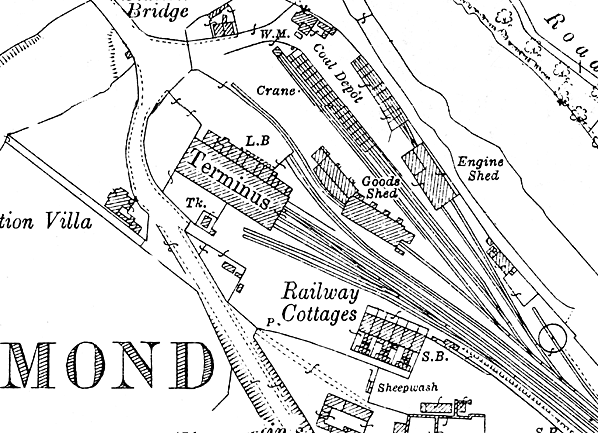
1904 25" OS map

Richmond station sometime around the turn of the 20th century and possibly during 1903. Features of note are the sloped-back platform, the result of the platform edge being raised in or around 1860, and the North Eastern stock stabled on the left. It comprises six and probably four-wheeled stock including what appears to be a six-wheel luggage brake. Livery would have been deep crimson, sometimes referred to as 'plum'. It has been suggested it was the funeral of a eminent person but this can, with reservation, be discounted as the bunting and dress are not appropriate for a funeral at this period. It can be seen that two of the women are wearing bustles (a type of skirt support) and investigations reveal the bustles are of a less prominent style worn during the very early years of the 20th century before the fashion disappeared altogether around 1905. Click here for a larger version of the picture with a more detailed caption. Copyright photo from Martyn Mugridge collection
old42.jpg) Richmond goods yard c.1935. The buildings shown are goods shed (left), engine
shed (centre) and gas works (right).
Photo from Roger Griffiths collection
Richmond goods yard c.1935. The buildings shown are goods shed (left), engine
shed (centre) and gas works (right).
Photo from Roger Griffiths collectionold49.jpg)
Richmond station c1930s Photo from John Place collection
old7.jpg)
Richmond Station in 1952 Copyright photo by from John Mann collection
old4.jpg)
Richmond Station in September 1956 Copyright photo by Richard Casserley
old5.jpg)
Richmond Station in 1963
Photo copyright Colour-Rail
 Richmond Station in December 1965
Copyright p hoto by Maurice Burns
Richmond Station in December 1965
Copyright p hoto by Maurice Burns
Richmond Station on 1st March 1969, the last day of public service. After closure to goods traffic in 1967 all the sidings were lifted leaving a single track for the passenger service
P hoto by Alan Brown 2.jpg)
Richmond Station in July 1978, at this time the station was used as a garden centre.
Photo by Alan Lewis from his Flickr web site
32.jpg)
Richmond Station in September 2005 during a ‘Rail Fayre’ organised to raise money and publicity for the subsequent restoration of the station seen below. P hoto by John Webb
Richmond Station in September 2009 P hoto by Nick Catford
Click here for more pictures of Richmond Station
old36.jpg)
